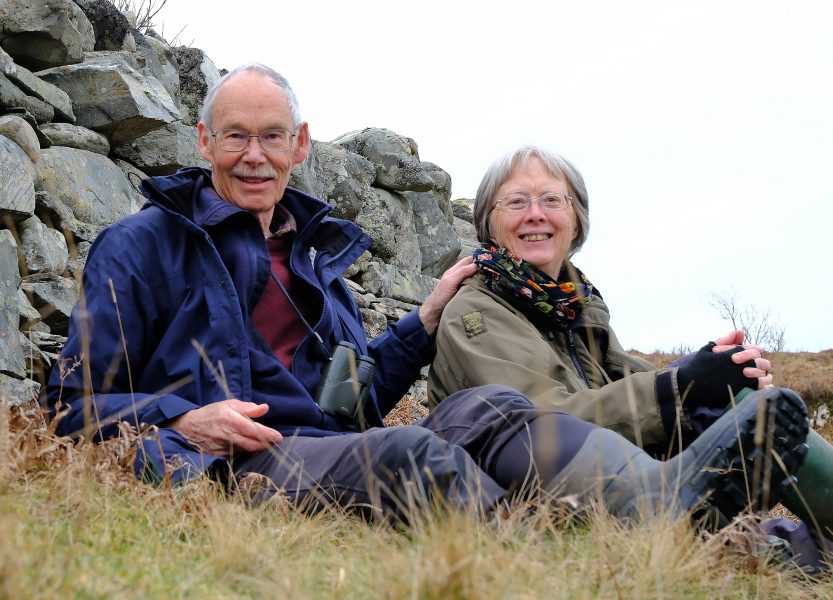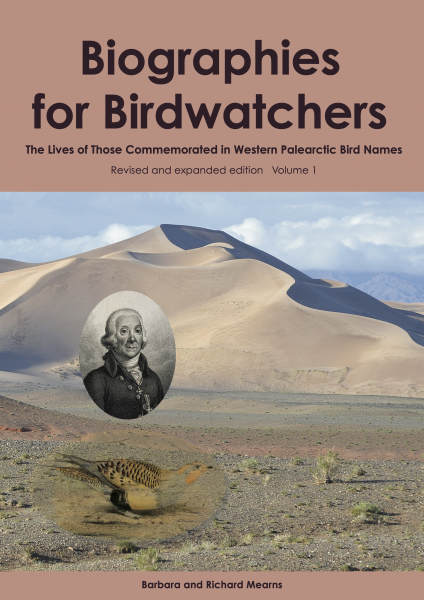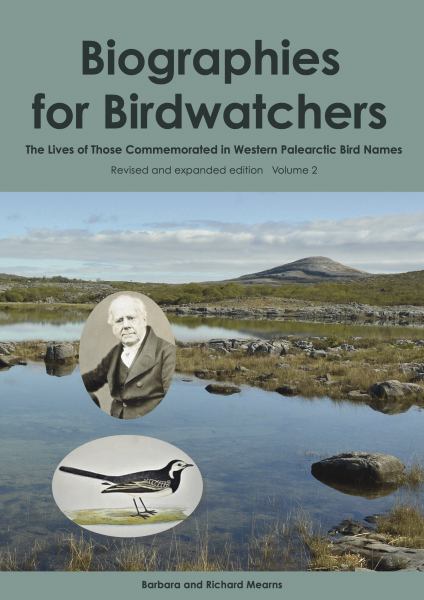An interview with Richard and Barbara Mearns on their book ‘Biographies for Birdwatchers, The Lives of Those Commemorated in Western Palearctic Bird Names’. Privately published in 2022. 2 softback A4 vols with over 250 portraits (396pp & 266pp). ISBN 978-0-9556739-3-1. £69.99 plus P&P, www.mearnsbooks.com.
Reproduced with permission from the Quarterly Newsletter (Issue No. 272, March 2024) of the London Natural History Society.

Barbara Mearns was born in Greenock, studied in Edinburgh, and then worked for seven years as an Occupational Therapist in Dumfries. Barbara served as Editor and Administrator, for twenty years, with the international wildlife conservation organisation A Rocha. Richard Mearns grew up in Somerset, graduated from Edinburgh University, then studied Peregrines in SW Scotland and Greenland, and Corncrakes in the Outer Hebrides. He retired in 2007 after 20 years as a countryside ranger, chiefly responsible for the Southern Upland Way. Together they have written five books on the early naturalists, including John ‘Kirk Townsend. Collector of Audubon’s Western Birds and Mammals’, (2007).
How did this book come about?
In 1983 we camped on the Seward Peninsula, Alaska, to photograph breeding Grey Plover and other waders. Watching Steller’s Eider, Sabine’s Gull, Wilson’s Warbler, Swainson’s Thrush and other eponymic species, we began to wonder who these people were. Back home, we discovered that though biographies were available for some, we would need to do our own research for others. We decided that short biographies of all 89 people commemorated in Western Palearctic bird names would make a fascinating book and Biographies for Birdwatchers was published in 1988. When Richard retired, he began an updated edition, published in 2022, adding in the many species new to the region and extending into Arabia and Iran which took the total of people with full species named after them to 163. This time he also included 179 people with subspecies named after them, adding up to a total of 342 people.
How many years was this book in the making?
For us, writing is mainly a winter task. For the first book, which took four years, we split the chapters equally between us. Richard was mainly responsible for the new book: revising the original text, researching new biographies, tracing portraits and organising translations from Spanish, German, French and Russian. It took him 15 winters.
What do you want to achieve with this book?
Most avian eponyms celebrate outstanding naturalists. They are a varied bunch, including explorers, writers, artists, biologists and conservationists. Our birding has been hugely enriched by our awareness of those who went before, so we would like others to enjoy their stories and realize how indebted we all are to these pioneers. The American Ornithological Society decided in 2023 to ditch all their vernacular eponyms: we hope that in Europe, we’ll keep this link to our heritage.
Is there a fun fact or something amazing you learnt during the writing of the book?
Frank Zino (of Zino’s Petrel) is a conservationist on Madeira. When he read our book he was astonished to discover that the Prussian naturalist Eduard Eversmann (Eversmann’s Redstart) who explored in Uzbekistan, appears in his mother’s family tree – the Zinos and Eversmanns are directly related!
Were there any memorable moments during the course of writing this book?
Countless! Following in Canon Tristram’s footsteps through Israel and watching Tristram’s Starlings near Mar Saba Monastery, where he took the type specimens. Visiting Cherryburn (now a museum) near Newcastle, where Thomas Bewick (of Bewick’s Swan) was born. Opening packages at home, containing long-sought portraits. In museums, handling 19th century bird skins bearing the collector’s original label.
For anyone who wishes to pursue this topic more, are there any online resources you would recommend?
The on-line Biodiversity Heritage Library is the easiest way to consult out of print books. It includes the illustrations too, but to appreciate the startling beauty of some hand-tinted plates you really need to visit a library.
Has your knowledge of ornithological history influenced your everyday birding?
Often, we think how lucky we are to have modern optics. It must have been so frustrating for early naturalists, trying to see birds well with the naked eye, or through 18th or 19th century telescopes – no wonder many of them shot birds and made skin collections. We’re grateful, too, for modern field guides. The first popular bird book in Britain was written by William Yarrell (of Motacilla alba yarrellii) and published between 1837-43, but it only provided one black and white illustration of each species.
Which of your subjects impressed you most?
Barbara: Alexander Wilson (Wilson’s Storm-petrel) is one of my heroes. Born in Paisley, Renfrewshire, in 1766, he left school at the age of ten to become a weaver. A political activist, he fell foul of the law and on his release from jail, emigrated to the USA, owning only his flute and his fowling-piece. Yet he became America’s first great field ornithologist, travelling thousands of miles alone, usually on foot or horseback. He taught himself to draw, writing and illustrating his nine-volume American Ornithology, full of beautifully written first-hand observations.
Richard: Robert Swinhoe (of Swinhoe’s Petrel) was in the British consular service in China from 1854 to 1875, when the Western world knew little about Chinese birds. He worked up and down the coast seeking out birds (even when later partially paralysed) and by the time he left China he had added almost 100 new birds to the Chinese avifauna.
How can I order a copy?
The book was privately published (just 300 copies printed), enabling us to have quality control and keep down the price. Our sole distributor is Wildside Books. Email wildsidebooks@hotmail.com. More at www.mearnsbooks.com


